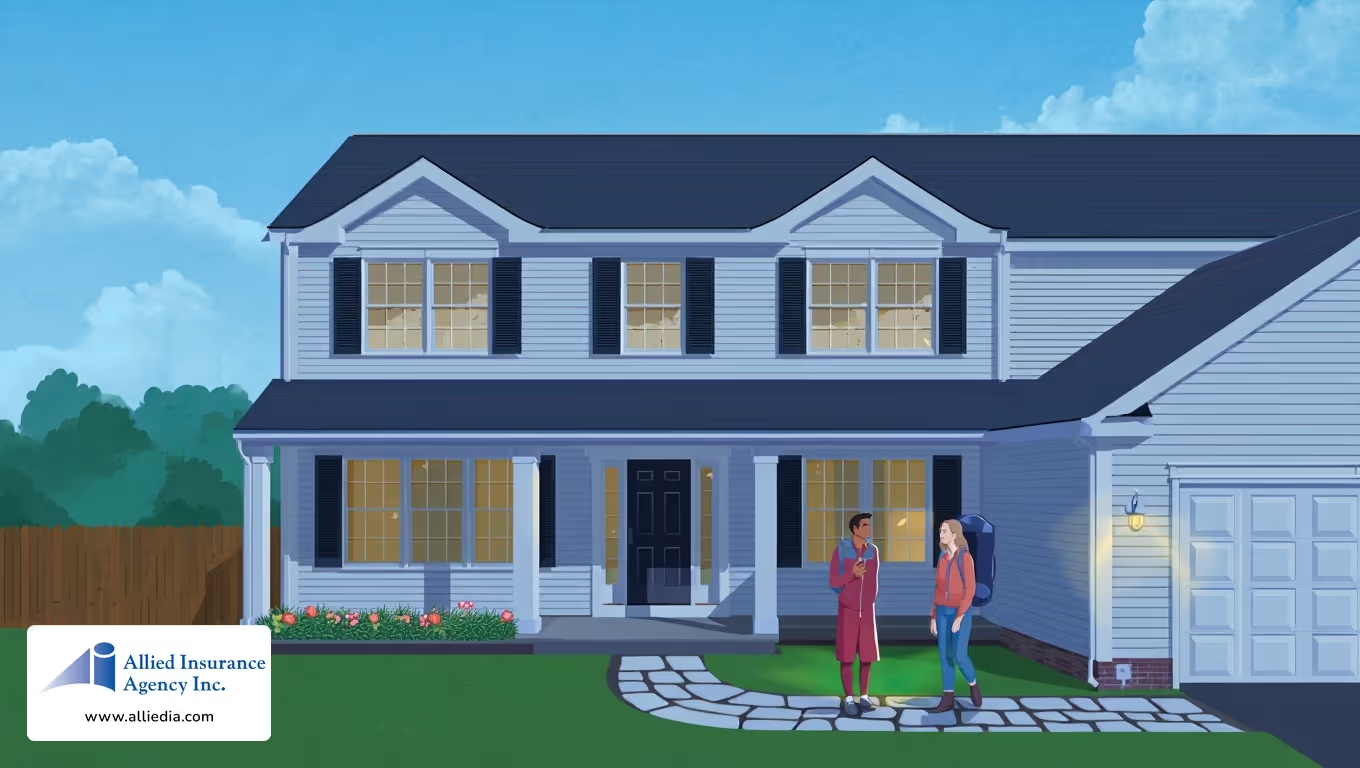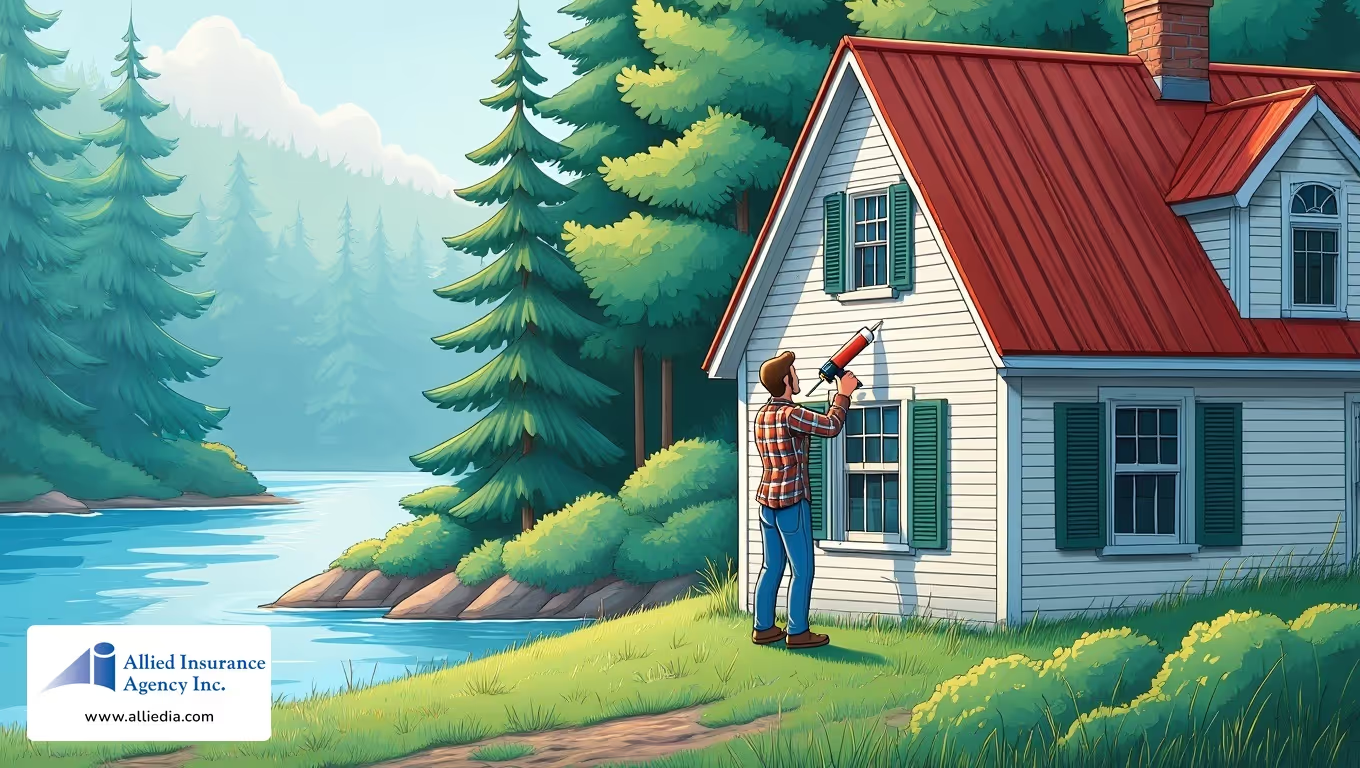
New Hampshire Home Insurance Discounts You Didn’t Know You Could Get!
An independent agency with local roots in Concord, Bow, and Hooksett explains how residents can lower premiums while keeping strong protection. This short guide highlights practical steps to boost savings, document eligibility, and align coverage with rebuild costs.
Statewide averages show lower premiums than the national norm, yet risks like winter storm damage and flood exposure still require smart policy choices. Readers will learn which savings tools work best and how to verify service and claims support.
Contact Allied Insurance Agency for a free N.H. home insurance quote. The agency helps customers compare coverage, evaluate premiums, and focus on customer satisfaction rather than just headline price.
Key Takeaways
- Local insight helps homeowners tailor coverage for Concord, Bow, and Hooksett risks.
- Bundling, protective devices, and claims-free history often yield the biggest savings.
- Flood protection usually needs a separate policy; some have a waiting period.
- Review dwelling limits and deductibles to avoid underinsurance at claim time.
- Use state consumer resources for help with complaints and comparisons.
Why New Hampshire homeowners can save more than they think
Local experience shows that many Granite State property owners get better pricing than national averages suggest. An independent Concord insurance agency perspective helps explain why typical premiums run lower and how market shifts affect individual policies.
How the state’s risk profile drives lower average rates
Moderate severe-weather exposure and relatively low crime levels keep the state's average premiums well below U.S. figures — roughly $1,185 versus $2,110 nationally, with a common $1,001 outcome for $350,000 dwelling scenarios.
Today’s market dynamics and what they mean for your policy costs
Costs have climbed about 27.2% over six years, including 7.2% in 2023 and 10.2% in 2024. Rising construction and labor prices push rates higher, while local underwriting still rewards maintenance and loss-prevention work.
- Neighborhood features, such as river proximity in Concord or wooded borders in Bow, affect local pricing.
- Insurers weigh corridor exposure in Hooksett and floodplain assessments when setting a rate.
- Regular policy reviews and home upkeep create tangible options to control future costs.
An independent insurance agent can translate these patterns into practical coverage choices that match property realities and the homeowner’s risk tolerance. Periodic reviews help keep coverage aligned and costs manageable.

What home insurance really costs in New Hampshire right now
Current premium figures show residents can often pay far less than national averages without lowering protection.
Average premiums vs. national trends and why NH runs about 44% lower
On average, the state posts annual premiums near $1,185 while the U.S. mean is about $2,110. For a $350,000 dwelling, the typical bill falls near $1,001. That gap reflects lower crime and moderate severe-weather exposure across many communities.
How dwelling coverage amounts and deductibles change your rate
Higher dwelling coverage raises the insurer’s exposure, so limits tied to realistic rebuild estimates keep costs sensible. Raising a deductible by roughly $1,000 often trims premiums about 10–15%, assuming the homeowner keeps an emergency fund.
- Credit-based pricing can push some households toward $2,060 annually.
- City-level differences matter: Nashua trends lower; Manchester and coastal areas run higher.
- Separate flood protection adds cost where flood zones apply; water-damage riders are optional but useful.
Independent agents help compare rate structures and coverage options so homeowners can balance protection and cost without sacrificing either.
home insurance discounts new hampshire: the essential list
Bundling and protective upgrades deliver the most consistent savings. Policyholders who combine auto or umbrella coverage with a dwelling plan often see one of the largest recurring reductions.
Bundling and multi-policy savings for homeowners
Pairing coverages simplifies billing and can qualify a household for meaningful rate cuts. Independent agents can compare companies to find the best stacked offers.
Protective device and loss-prevention credits
Monitored alarms, leak sensors, and smart electrical detectors reduce loss risk and usually earn credits. Keep installation invoices and monitoring contracts to validate savings at renewal.
Renovations, new roof, and claims-free rewards
Updated roofs, modern plumbing, and current heating systems lower underwriting risk. A clean claims record over several years often unlocks loyalty-style premium relief.
Loyalty, paperless, and pay-in-full incentives
Administrative credits from paperless billing, auto-pay, or paying annually are common and stack well with safety and multi-policy reductions.
- Tip: Properties within about five miles of a fire station may qualify for extra rate benefits.
- Document upgrades with permits, photos, and receipts to speed verification.
How to qualify for deeper savings without sacrificing coverage
Practical steps—credit care, a sensible deductible, and a quick risk walkthrough—can reduce costs while preserving strong coverage.
Credit-based pricing and responsible habits
New Hampshire allows credit-based pricing. Consumers with weaker credit can pay about 74% more; that can push annual bills well above the state average.
Maintaining on-time payments and low card use improves risk scores and lowers quotes over time.
Choose the right deductible and keep liquidity
Raising a deductible by $1,000 typically trims premiums roughly 10–15%.
But that move requires an emergency fund large enough to cover the out-of-pocket cost if a loss occurs.
- Do a home risk walkthrough to spot maintenance needs before changing limits.
- Avoid small claims that can erase claims-free savings.
- Bundle liability lines and document upgrades to strengthen renewal leverage.
- Ask an independent agent to model scenarios so the policy fits budget and protection.
Property features that can unlock additional discounts
Targeted upgrades to the roof and mechanical systems can lower risk and reduce yearly costs. In this climate, small investments often affect underwriting and coverage options.
Roof age, materials, and replacement upgrades
Roof age and material choice drive winter resilience. Impact- and ice-resistant shingles, plus proper venting and insulation, cut the odds of ice-dam related interior damage.
New or well-documented roof replacements often improve a dwelling's underwriting profile and can lower local rates.
Plumbing, electrical, and heating updates that reduce risk
Modern plumbing, leak sensors, and automatic shutoff valves limit water loss and support verified savings requests.
Upgrading panels, adding arc-fault and GFCI protection, and keeping heating systems serviced reduces fire and freeze exposure. Proximity to a fire station also affects the rate outcome.
- Keep permits and invoices to prove upgrades.
- Use monitored devices and service records to document risk control.
- Ask an independent agent which features return the most value for a given property.
Contact Allied Insurance Agency for a free home insurance quote.

Coverage choices that lower long-term costs
A well-tuned policy can prevent underinsurance when rebuilding costs spike after a regional event.
Dialing in dwelling coverage means sizing limits to local rebuild costs, not market value. That keeps the sum insured aligned with what it takes to reconstruct the structure after a covered loss.
Extended replacement cost and water protections
Extended replacement cost options help when labor and material prices rise after storms or regional demand. Sewer and water backup endorsements address common plumbing failures tied to freeze-thaw cycles and aging pipes.
Scheduling valuables and managing limits
Schedule high-value items so they exceed default sublimits. Liability limits and endorsements should be balanced with property protection to avoid gaps that lead to costly out-of-pocket losses.
- Set dwelling coverage using local rebuild estimates, not sale price.
- Add extended replacement cost to absorb post-event inflation.
- Include sewer/water backup for plumbing-related losses.
- Buy separate flood coverage where maps or experience show exposure; plan for waiting periods.
Independent agents can compare policy forms and endorsements to keep rates sensible while improving protection for a New Hampshire residence.
Local insights: Concord, Bow, and Hooksett pricing nuances
Proximity and land use change premiums quickly. Concord, Bow, and Hooksett sit close enough that town-level details shift underwriting and rate outcomes. Local agents in the Merrimack Valley help homeowners compare companies and coverage that fit each neighborhood.
Concord: river proximity, urban density, and liability considerations
Concord averages near $952, but river-adjacent parcels often need a separate flood policy. Flood maps and waiting periods matter, so buyers should check exposure early.
Urban density raises foot-traffic and visitor liability risks. Higher liability limits may be wise for rented rooms or frequent guests.
Bow: suburban profile and wildfire-adjacent properties
Bow trends about 5% under the state average. Newer infrastructure and lower density support competitive rates.
Homes near wooded tracts should add defensible-space work and roof upkeep to reduce wildfire and tree-fall risks.
Hooksett: corridor exposure and mixed-use neighborhoods
Hooksett varies by flood zone and Route 3 corridor proximity. Traffic, commercial adjacency, and mixed zoning can change underwriting and the final rate.
Within ZIP codes, fire response times and hydrant access can create price gaps. Documenting roof, electrical, and monitored alarms offsets risk concerns tied to location.
- Review flood maps for Concord and parts of Hooksett; standard policies exclude flood.
- Adjust liability to match property use and visitor patterns in denser areas.
- Compare multiple companies for area-specific rates and ask a local agent to contextualize quotes.
Contact Allied Insurance Agency for a free insurance quote. Homeowners can also see practical ways to lower cost and improve protection by visiting how to get cheaper coverage.
Common New Hampshire risks and the discounts that mitigate them
Seasonal threats—from deep snowfall to thaw runoff—shape what protections and credits are most valuable. This section translates those risks into clear, practical steps residents can take to lower loss odds and support underwriting credits.
Winter storms, ice dams, and roof readiness
Heavy snow and ice increase load and promote ice dams. Routine roof inspections, improved attic insulation, and proper ventilation reduce that risk and help avoid interior water damage.
Cleaning gutters and removing roof snow where safe also prevents meltwater backup. Document services and receipts to support requests for policy credits and to preserve a claims-free track record.
Water and flood: what’s covered, what needs a separate policy
Standard coverage usually handles many winter-related burst pipes and storm damage, but flood from snowmelt or surface runoff is excluded. Flood policies often have waiting periods, so buy early if maps or local history indicate exposure.
For properties with basements or low yard grades, add water-backup endorsements and maintain sump pumps. These steps lower the chance of a claim and can qualify the owner for risk-control recognition.
Proactive maintenance that helps prevent claims
Simple, regular tasks pay off: test heating systems, service plumbing lines, trim trees near structures, and install leak sensors and backflow devices. Sump pump checks and gutter upkeep reduce water intrusion and the need to file a claim.
- Inspect roofs each fall and after major storms.
- Keep records of heating and plumbing maintenance.
- Consider endorsements for detached buildings and specialized equipment.
- Avoid small claims when possible to protect long-term rates.
Practical action: homeowners seeking a deeper overview can compare options in the New Hampshire home insurance guide, then work with an independent agent to match coverage to seasonal risks.

Consumer protections and smart shopping in the state
An informed shopping approach pairs rate comparisons with checks on claim responsiveness and customer satisfaction. This helps homeowners pick coverage that matches local risks and budget needs.
Working with an independent agency for competitive quotes
Independent agencies survey multiple companies to deliver competitive quotes and tailored policy options. They explain limits, exclusions, and add‑ons like water backup or flood endorsements so a property owner understands trade-offs.
Agents also factor in service reputation and claims handling, not just the lowest rate. That approach reduces surprises if a claim happens.
Using the New Hampshire Insurance Department as a resource
The New Hampshire Insurance Department oversees market practices and offers consumer tools. Residents can call 800-852-3416 or email consumerservices@ins.nh.gov for education and complaint help.
Third‑party studies, such as J.D. Power, add perspective on customer experience and service levels across companies. Combining official resources with independent agent support gives a clear path to better coverage and fair treatment.
- Compare quotes and coverage side‑by‑side.
- Prioritize claim responsiveness and documented service expectations.
- Keep records and review policy terms annually to match changing property risks.
How to get multiple quotes the easy way
Gathering a few key facts about the property makes getting multiple quotes fast and accurate.
What to collect first: square footage, construction type, roof age, recent system updates, and any monitored safety devices. Include a concise prior-claims history and current policy limits so insurers can model accurate risk.
Compare more than price
Ask each company for scenarios that show different deductibles and varying dwelling coverage levels. Include rebuild estimates and note safety upgrades so proposals reflect true replacement cost and risk control.
Weigh coverage options and service
Evaluate endorsements for water backup, realistic liability limits, and how personal property is valued. Check service details: claim reporting, typical response times, and after-hours support. Paperless billing and claims-free history often change offers and should be recorded when requesting quotes.
- Request separate flood illustrations if maps show exposure.
- Ask about renovation credits, protective-device recognition, and pay-in-full options.
- Consider umbrella liability and scheduled valuables to avoid coverage gaps.
Work with an independent agency that can consolidate proposals into an apples-to-apples summary across multiple insurance companies. This saves time and highlights the best balance of rates, coverage, and customer service.
Contact Allied Insurance Agency in Bow, N.H. for a free insurance quote.
Conclusion
A clear action plan—document upgrades, compare proposals, and schedule annual reviews—turns rate pressures into manageable steps.
New Hampshire remains among the more affordable states for homeowners, but rising costs mean proactive steps matter. Right-size dwelling coverage to real rebuild estimates and add water or flood endorsements where exposure exists.
Prioritize roof checks, leak detection, and routine maintenance to limit damage and preserve a clean claims record. Compare quotes with an independent agency to focus on service, claims support, and long-term satisfaction—not just the cheapest rate.
The best home insurance outcomes balance solid protection with disciplined cost control tailored to the property and its risks. Contact Allied Insurance Agency for a free home insurance quote.



